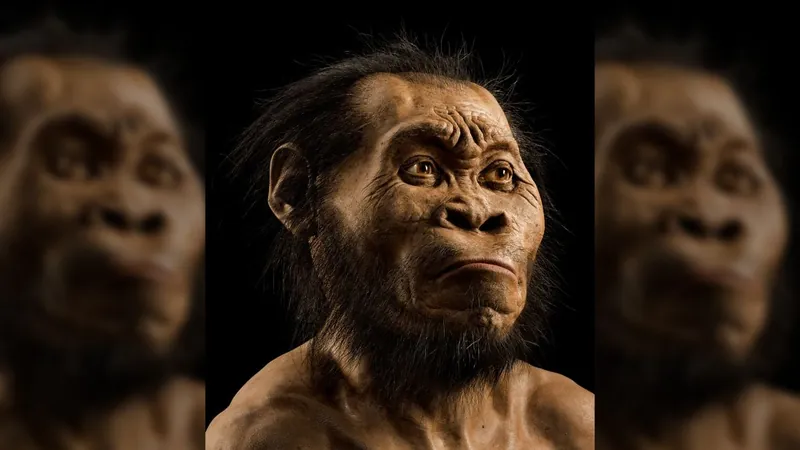
Historic Discovery: Homo Naledi Engaged in Burial Practices Over 250,000 Years Ago
2025-03-28
Author: Nur
Groundbreaking Revelation
In a groundbreaking revelation, researchers have unveiled compelling evidence that Homo naledi, an extinct relative of modern humans, engaged in burial practices and created cave engravings approximately 250,000 years ago. This discovery contradicts long-held beliefs that only Homo sapiens and Neanderthals practiced such complex behaviors.
Research Findings
The research was published in the journal *eLife* and spans an impressive 250 pages, detailing the team’s findings and arguments that suggest these early hominins engaged in ritualistic burials. Originally suggested in a 2017 study, the hypothesis has faced scrutiny; however, the latest revisions appear to have successfully swayed a number of skeptics.
Discovery Background
Homo naledi was first uncovered in 2013 within the Rising Star cave system in South Africa. To date, over 1,500 bones from multiple individuals have been excavated from this 2.5-mile-long (4 kilometers) network of caves, revealing significant information about their anatomy. Standing roughly 5 feet (1.5 meters) tall and weighing around 100 pounds (45 kilograms), Homo naledi possessed dexterous hands and small, yet intricately developed brains, raising questions about their cognitive and social capabilities.
Evidence of Burial Practices
The team, led by paleoanthropologist Lee Berger, presented findings during a 2023 press conference that outlined two oval-shaped pits in a cave chamber, which contained skeletal remains indicative of deliberate burials. One of these pits also housed a stone artifact, likely a grave offering, found near the bones. Berger asserted that these findings meet the criteria for understanding human burial practices, which could predate the known practices of Homo sapiens by an astounding 100,000 years.
Skepticism from Experts
Despite the strong claims, not all experts are on board. Critics argue that the evidence presented lacks sufficient support, urging for further studies by independent researchers to validate the findings. Anthropologist Sheela Athreya described the team's interpretations as potentially speculative and noted the need for caution when drawing conclusions from the data.
Additional Evidence
In an effort to bolster their hypothesis, Berger’s team has gathered additional evidence, including reconstructions detailing the journey from death to burial in the cave system. This new data has prompted some experts to concede that there is convincing evidence for repeated and intentional burials among Homo naledi.
Cultural Complexity
Moreover, abstract engravings discovered on the cave walls contribute to the growing narrative of Homo naledi's cultural complexity. These markings, resembling lines and geometric shapes, suggest that these hominins undertook meaningful alteration of their environment, preparing the rock surfaces for engraving, indicating a level of cognitive sophistication.
Implications of Findings
Further research posits that the shared deposition of bodies and the captivating engravings could indicate a collective understanding or ritual concerning death, akin to the concept of ‘shared grief’ observed in modern humans.
Ongoing Inquiry
However, skepticism remains prevalent among some researchers regarding the interpretations of these engravings as evidence of advanced thought. The complexity in the manner and methods utilized by Homo naledi to access the Rising Star cave system continues to provoke inquiry, leaving room for further exploration into their cultural and social behavior.
Conclusion
As this research continues to unfold, it may reshape our understanding of human ancestry and the evolutionary milestones that define what it means to be human. Stay tuned, as the implications of these findings could redefine our perception of early hominin social lives and their capacity for cultural expression!


 Brasil (PT)
Brasil (PT)
 Canada (EN)
Canada (EN)
 Chile (ES)
Chile (ES)
 Česko (CS)
Česko (CS)
 대한민국 (KO)
대한민국 (KO)
 España (ES)
España (ES)
 France (FR)
France (FR)
 Hong Kong (EN)
Hong Kong (EN)
 Italia (IT)
Italia (IT)
 日本 (JA)
日本 (JA)
 Magyarország (HU)
Magyarország (HU)
 Norge (NO)
Norge (NO)
 Polska (PL)
Polska (PL)
 Schweiz (DE)
Schweiz (DE)
 Singapore (EN)
Singapore (EN)
 Sverige (SV)
Sverige (SV)
 Suomi (FI)
Suomi (FI)
 Türkiye (TR)
Türkiye (TR)
 الإمارات العربية المتحدة (AR)
الإمارات العربية المتحدة (AR)